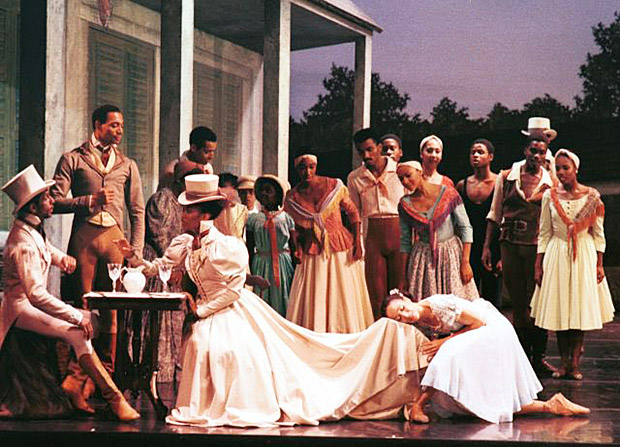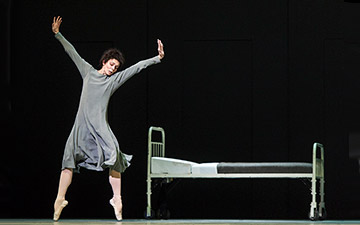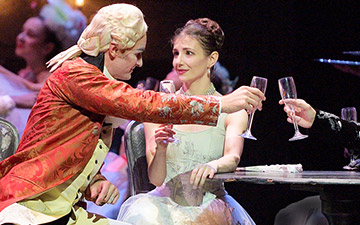
© Dance Theatre of Harlem. (Click image for larger version)
Dance Theatre of Harlem
Creole Giselle
★★★✰✰
Streamed archive recording from September 1987 for Danish TV
Relay 6 June 2020
www.dancetheatreofharlem.org/dthondemandvirtualballetseries
www.dancetheatreofharlem.org
The premiere of Dance Theatre of Harlem’s Creole Giselle took place not in New York but in the London Coliseum on 18 July 1984. I had interviewed DTH’s founder director, Arthur Mitchell, for a feature about the production before reviewing it for The Observer, so was privileged to be shown some of the research that went into its creation.
Giselle was the first full-length classical ballet that Mitchell’s company of black American dancers would perform. He thought there would be no point in their pretending to be Rhineland peasants, so decided to set the 19th century ballet in pre-Civil War Louisiana. Before the 1861-65 war between the northern and southern states of America, ‘free people of colour’ were able to own property in and around New Orleans. A caste system grew up between Creole families of long-standing and recently freed slaves: this would prove a social barrier between Giselle and her faithless lover, Albert, the privileged son of a rich landowner.
Giselle’s absent father, probably a white slave-owner, granted her, her mother and grandmother freedom after the child was born. Berthe, known as Madame Lanaux, was set up on a small farm; Giselle did needlework to earn extra money. Her friends were field hands on sugar plantations, gathering together with the locals for a sugar-cane party rather than a grape harvest. Mitchell and his collaborator on the production, the stage designer Carl Michel, researched the clothing and farm buildings of the period (1841, according to the date on Giselle’s tomb) as well as burial customs in the swampy surroundings of South Louisiana.
Not all this background information is evident in the ballet, though cast members had absorbed detailed biographies of their characters. The filmed account, made in a television recording studio in Aarhus by Thomas Grimm in 1987, has an elaborate set showing that Mme Lanaux was no pauper. Her farm has outbuildings and picket fencing; her house has a veranda outside and the interior, glimpsed in camera shots, is well-appointed, with a carafe of wine and crystal glasses on a dainty table (and possibly an indoor loo for visitors).
Everybody is dressed for the heat, with sun hats or headwraps. There’s a distinction in clothing between mature women and young girls, like Giselle, who wear flowers in their hair. The higher-class hunting party sport top hats and tailored riding habits, with long skirts in fine fabrics for the women. Though Bathilde and her retinue behave as though they are superior beings, the locals aren’t overly impressed. Berthe has no qualms about challenging Bathilde’s imperious command for Giselle to dance for her.
The scenario and choreography for DTH’s Giselle are much the same as for a more traditional version. The staging was by Frederic Franklin, based on his experience with the Ballet Russe de Monte Carlo in the 1940s. He kept the mime sequences, apart from Berthe’s warning of the fatal vengeance of the Wilis. Though Giselle has a weak heart, she dies of her self-inflected stabbing from Albert’s swordstick when she learns of his duplicity. She is buried in an above-ground sepulchre, surmounted by a cross, in a bayou overhung with Spanish moss. Albert reaches her tomb by boat, rowed by his loyal servant.
In the Danish TV recording, the cast is almost the same as for the premiere three years earlier. (The exception is Augustus van Heerden in the ‘Peasant’ pas de deux with Judy Tyrus. I saw Joseph Cipolla, who subsequently joined what is now Birmingham Royal Ballet.) Giselle is Virginia Johnson, the principal dancer who became DTH’s artistic director in 2009; Albert is Eddie J. Shellman, who later performed as a guest with the Royal Ballet in 1993; Hilarion is Lowell Smith; Bathilde is Thea Ward, and Myrta, Queen of the Wilis, is Lorraine Graves.
The big problem with the online streaming is that the VHS format has been reduced, cutting off the top and bottom of the video: the dancers’ feet are often obscured, as is the upper part of the set. The reproduction isn’t sharp and a filter used for Act II in the misty bayou makes it even hazier. Special effects for the ghostly Wilis are risibly dated and close-ups of Albert’s agony are unfortunate.
That said, the performances are worth seeing. The story is clearly told, the dancing and acting well executed. Franklin’s account of the choreography is simpler, less acrobatic than we are used to seeing these days, with lower leg lines in arabesques and renversés. The ‘Peasant’ pas de deux has intricate batterie for both performers, with swift pirouettes and steely pointe work by Judy Tyrus as the girl. Virginia Johnson’s Giselle is appealing in Act I; as I wrote of her debut in 1984, ‘She has a luminous innocence that makes every thought and feeling transparent’. Her mad scene, dark hair clouded around her distraught face, is realistically distressing. In Act II, she doesn’t attempt the Romantic style of the original 19th century ballet, with its wistful carriage of the head and neck and softly rounded arms. Instead, she uses her long limbs to reveal Giselle’s striving to escape her fate as a deadly bride of the bayou.
Tall Lorraine Graves has impressive elevation and imposing authority as Myrta, armed with a rosemary branch (for remembrance) that snaps when Giselle defies her. The Wilis wear silken dresses in shades of grey with fluttering draperies that drift about them as they move. Giselle’s costume is the palest because she is a novice, about to be inducted into the vengeful cult. She materialises by special effects magic and vanishes from Albert’s arms when he first encounters her in the cemetery – no need for high-flying lifts.
Shellman’s Albert is a practised philanderer in Act I, brutally disowning Giselle when she and Bathilde confront him. (His mimed answer to Bathilde’s queries: ‘Why are you here, why are you dressed like this?’ is to pretend that he was hunting an animal, a plausible variant on the usual shrug: ‘Well, it was just for fun’.) He is truly repentant in Act II, though no virtuoso as a danseur noble in his variations. The Wilis nearly get him, as they did Hilarion, by advancing en masse, a far from ethereal pack, until dawn finally breaks.
It’s clear that Giselle forgives him, movingly seen in close-up as he bows his head in sorrow before she evaporates. The ballet ends with Albert prostrate beneath her stone sepulchre, already engraved with her full name and the dates of her brief life.
This vintage recording, made 36 years ago, is a landmark in Dance Theatre of Harlem’s 51-year-old history. Mitchell’s Creole Giselle gave the company’s dancers ownership of a revered 19th century Romantic ballet, while giving audiences a fresh experience of Giselle and of black ballet dancers’ abilities. Many of the performers seen in the film have gone on to have rewarding careers as dancers, teachers, coaches and leaders. In a video feature to mark the company’s 50th anniversary, three of them speak of their pride in changing people’s perceptions of what ballet can be and whom it is for.

















You must be logged in to post a comment.